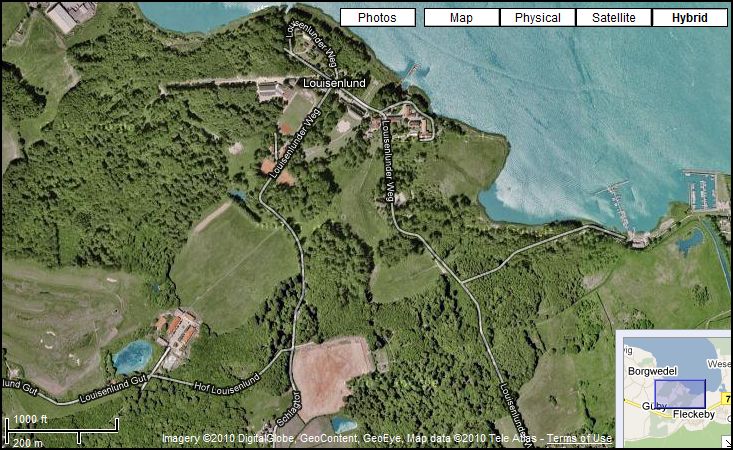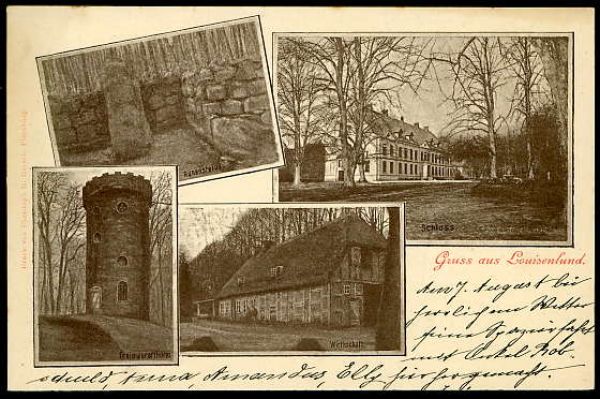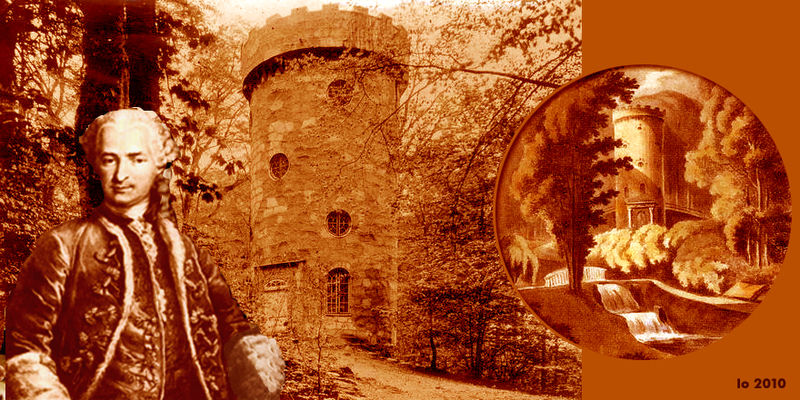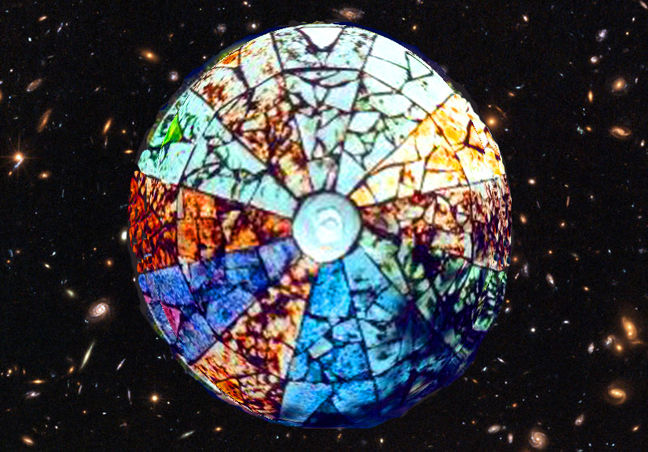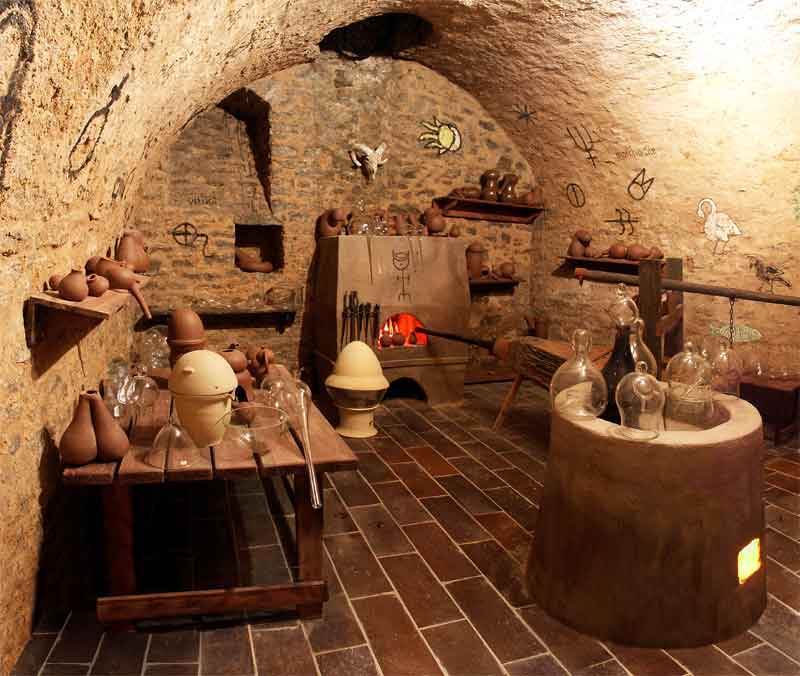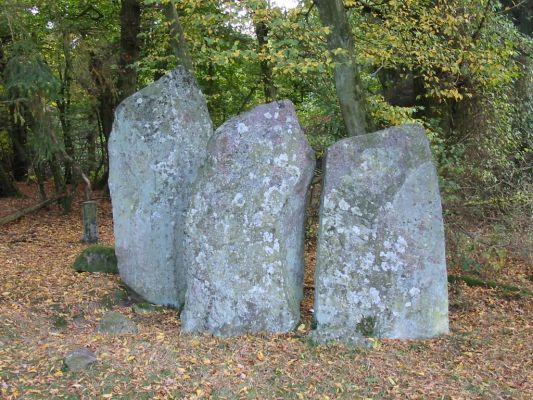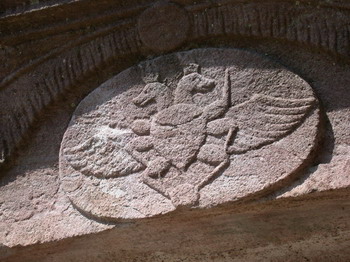Hermetic Garden 2
Part 2 - HERMETIC GARDEN: Louisenlund As Sacred Space & Mystery School, by Iona Miller
Landscape, Music, Myth and Transformation
VIDEO - http://vimeo.com/13114505
Cognition, language, myth and art: none of them is a mere mirror simply reflecting images of inward or outward data; they are not indifferent media, but rather true sources of light, the prerequisite of vision, and the well-springs of all formation. (Cassirer 1955a, p. 93)
Ye call me Master and obey me not.
Ye call me Light and see me not.
Ye call me the Way and walk it not.
Ye call me Right and desire it not.
Ye call me Wise and follow me not.
Ye call me Fair and love me not.
Ye call me Eternal and seek me not.
Ye call me Gracious and trust me not.
Ye call me Just and fear me not.
We give you Love, 'tis all we've got.
For Love unties the Gordian Knot.
Written on a church wall in Germany, attributed to St. Germain
HE was, perhaps, one of the greatest philosophers who ever lived. The friend of humanity, wishing for money only that he might give to the poor, a friend to animals, his heart was concerned only with the happiness of others.--Mémoires de Mon Temps, p. 135. S. A. LE LANDGRAVE CHARLES, PRINCE DE HESSE. (Copenhagen, 1861.)
Louisenlund Satellite View
http://www.satelliteviews.net/cgi-bin/w.cgi/?c=gm&DG=SCH
Life Art
Art, including alchemy and landscape art, reveals and so reflects the multi-layered contents of the psyche and presents them for the gaze thereby opening the "field of vision." There is life both within the art and of the art. Art is the embodiment of affect. Genuine art has symbolic depth. Revealing "hidden ground" deepens the field. It is 'grounding.' It ignites the alchemy of enlightenment -- spiritual movement into the physical world.
The 'making' of art is formative in "awakening" -- in coming to consciousness. It sheds light on elements previously in the shadows. It links mythic events to the physical landscape. This allows the psyche to fix on well-known images such as familiar mountains, streams, lakes, etc., and then gradually move beyond them into an inner mythic landscape.
Connection to Source is the basis of creation, which manifests something unique from formless nothing. We draw apart from our fellows, whether up the mountain, into the desert or shore, or away to our closet, but always into a solitary silence. Being creative requires a capacity to be reborn anew every day. The will to be, the emergent property, the unfolding of self-in-reality is always potential, until the moment of existence - then, there you are!
Hermetic Garden
Nature and wilderness invite flow between spirit, soul and ego. We go for expansion, to feel more than our puny selves. Nature’s threats are not to the ego or self alone, but to the entire organism. They require instinctual, intuitive and visceral responses involving the whole person.
A fiercely lived life is an artform -- illumination in action, based on discipline, practice and service. The specific “Art” is alchemical, a merger of inner and outer reality in One World. The Hermetics had a formula from the Emerald Tablet of Hermes for this realization, encoded in the anagram VITRIOL. It is a formula for visualizations which take one to a precise location in the inner landscape, for the specific purpose of uniting body, soul and spirit.
The formula, a call to meditation, is Visita Interiora Terrae Rectificando Invenies Occultum Lapidem. These seven words relate directly to the seven chakras, whose activation is the key to making the Philosopher’s Stone, wholeness. When the chakras function correctly, a ray of incomparable coherent light is created that is more than metaphorical.
Roughly translated the alchemical formula means, “Visit the interior of the earth, and by rectification you will find the hidden stone.” Rectification implies alignment. It relates to inner practice the same way in the Louisenlund of the heart as it does in Egypt. It correlates with Illumination and activation of the Third Eye, which allows us to “see through” and beyond. Clarity means all truth is found within our own human consciousness, and the lives of great saints and mystics reflect this Truth.
The Path of Nature
Landscapes project psychological states. Sacred settings and processes uncloak embodied images that were formerly vague sense impressions; they embody meaning. Their psychosensory impact of nondiscursive art forms does not require verbal interpretation. We gaze upon it and it effects us in a feedback process, imagined in alchemy as The Pelican.
Cooking the prima materia or making the garden brings life into the picture, uncloaks and congeals hidden images, and enlivens mythical associations. It creates a magic circle, or island of consciousness, in the sea of unconsciousness filled with living creatures of infinite variety. Art is a crucibe of consciousness and culture. So is Freemasonry which activates the hero's journey motif. It is a psychological journey that echoes mythic forebearers. It is the perennial story of The Seeker and The Quest of the four stages of the spiritual journey, the alchemical process, and life itself.
Alchemy has long know what physics now confirms - we are not purely physical. We are more than the activity of carbon and proteins. Part of us exists outside the physical world.The brain and how we perceive the world -- are a mystery on par with understanding the universe and the origin of life. We've ignored a critical component of the universe, shunted it out of the way because we didn't know what to do with it. This component is consciousness -- us, the great observer.
The hidden ground of our experiences is the deep source of our inspiration and transformation. Conscious experiences belong to slipstreams of consciousness, and these streams are part of nature’s process. They can be described in physical and psychological terms. As Above, So Below can be understood in relation to our perception of fractal embedding.
Experience is a process rooted in the stream of consciousness and happens “to” a person in that stream of consciousness. Each person is an aspect of nature’s process whose stream can flow forth like a fountainhead to quench and nourish many over the course of time.
Phenomenal experiences, including altered states, happen to specific people in specific places, perhaps never to be repeated. The mythic soulscape of a place is formed of these personal events and the holographic memories they infuse in that place, particularly in the case of sacred ground. They condition the way we think about that place from such a time forward.
The archetypal field of illumination encompasses the All and Everything. It is the soulscape of The Journey, the Pilgrimage to the sacred heights and depths, which is more than a symbolic or metaphorical journey. It is a journey to the center of the earth, our earth, our own spiritual Ground of Being, whether we conceive of it in eastern or western terms.
Absolute darkness has an initiatory quality - the metaphor of moving from the darkness of ignorance into the illuminative light. But it is more than a metaphor. All wisdom traditions have used sensory deprivation and darkness (such as caves, tunnels, catacombs, or special chambers), as a shamanic mind-altering force. Alchemists believed that a substance must be destroyed before the essential part of it could come to life. To get through the gate of dissolution to the state of exaltation, one had to pass through twelve gates before the Philsopher's Stone was obtained. This is the drama of the soul. They spoke of four elements - fire, air, earth and water -- and three principles called mercury, salt and sulpher. The seeds of male and female metals must be brought together to produce the elixir. Caves were the original sensory deprivation chambers. The ancients associated caves with the womb of the earth, life and death, the afterworld, and the place of healing. They made petitionary art in these caves in an attempt to create magical outcomes for their survival. The cave is a bubbling cauldron of darkness and silence, with an alchemical interior that is the hotbed of incubation and transformation, of that which is concealed.
The Death-Rebirth Cycle
DEATH REBIRTH is a generic cycle of nature with typical phenomenology:1) ego death or subjective feeling of being dead; 2) peace and well-being; 3) disembodiment; 4) visions of material objects and events. The Transcendental phase includes 5) tunnel or dark zone; 6) evaluation of one’s past life; 7) light; 8) access to a transcendental world, entering in light; 9) encounter with other beings; 10) return to life.
Symbolization helps differentiate consciousness mediating it through material objects. All alchemic operations, regardless of their individual type have at their base the fundamental idea of the transferability and material detachability of attributes and states. Sacred settings induce reverie. The participants become familiar with the articulated process, exploring and acknowledging the implications. Further contemplation bring assimilar and reintegration, repeating the alchemical axiom: Solve et Coagula.
Louisenlund of the Heart: Pilgrimage to a Mythic Landscape
St. Germain met Karl of Hesse-Kassel, the Danish governor of Schleswig-Holstein, in Hamburg and visited him in the castle Gottorp in Schleswig. Louisenlund is a lush estate on Bornholm Island in the Baltic on the Heartline of Europe. He remained his teacher and friend for four years, until he died February 1784 in Eckernförde, his last residence and working office near Louisenlund. On March 1784 he was buried at St. Nicholas Church.
Sacred places remain powerful in their real and symbolic status. Louisenlund was sacred in neolithic times and perhaps earlier. It lies on the Heart Line of Europe, a north/south-orientated earth energy line that is both a planetary electro-magnetic meridian and a ley line of etheric energy that is part of the etheric light body of the planet. It approximately follows the 9° longitude and passes through the heart chakra of Europe, which also forms the heart chakra of the Heart Line (hence the latter's name).
This heart chakra appears as the Constance landscape zodiac centred on the town of Constance and embracing Lake Constance, the High Rhine and the Isle of Reichenau, which famously houses the skull of St George and a vial of Christ’s blood (i.e. a Holy Grail). The throat chakra of the Heart Line is formed by the Exterland landscape zodiac, centred on the famous Externsteine (‘Dragon Stones’) in northern Germany.
The brow chakra lies in Jutland, Denmark, and the crown chakra in Norway. Milan in northern Italy is the metropolis that focuses the solar plexus chakra, and the sacral and root chakras lie in the islands of Corsica and Sardinia respectively. The ancient city of Carthage in Tunisia may at one time have marked an extension of the root chakra across the Mediterranean into North Africa. St. Germain had seen all these places, including Tunisia.
Since the seventeenth century, the comprehensible world of the Vitruvian architect and mathematician and the occult and mystical world of the followers of Hermes Trismegistus and Christian Rosencreutz became two important elements of the freemasonic thought. Freemasonry was heavily influenced by the Renaissance concept of the architect.
The Vitruvian concept of the architect and the techniques and styles of architecture detailed by Vitruvius were considered relevant to the education of architects and essential elements in the education of a gentleman. In Vitruvius's main work The Ten Books of Architecture (first translated into English in the eighteenth century), the architect is seen as the master of all the arts central to human knowledge, including the mathematical arts, thus becoming the Renaissance ideal, the Universal Man.
St. Germain's contemporary, William Herschel in his 1789 paper "Remarks on the Construction of the Heavens," described them as a "luxuriant garden" ceaselessly germinating, blooming, fading, and reviving. The landscape garden was conceived in England between 1710 and 1730, which coincides with the diffusion of Freemasonry in England and Europe. Many landlords and intellectuals of the eighteenth century were Freemasons. Freemasons believed in virtue, progress, equality, and they contributed to the preparation of the soil for the late eighteenth century democratic revolutions.
Rosicrucian themes included the Quest, the pursuit of some vision or ideal; the theme of the Initiatory Journey or pilgrimage, the journey of spiritual discovery; and the theme of special places, places that are charged with spiritual or magical power.
Louisenlund, with its sacred megalithic history became Prince Karl and St. Germain's mundus imaginalis, or imaginal realm of visionary encounters with revelatory spiritual figures. St. Germain had visited the visionary world of Persian spirituality. He likely spent time in Constantinople and Egypt. He claimed two journeys to India, and even China. His knowledge of silks and dying processes was gained in the East.
Enlightenment ideals (tolerance, equality, universalism, civic duty, natural religion, morality) which they helped propagate through their international links were also reflected - by means of iconography and design—in the early "emblematic" landscape garden. That the "wise man" following moral behavior becomes the "Architect of his own life" corresponds to the idea of the reconstruction of an internal moral Temple that each Freemason endeavoured to reconstruct with his behavior. For Hermetists, "ascension" was not a mere metaphor that could be used interchangeably with "resurrection" or "ransom from captivity."
The purpose of masonic initiation was to lead the probationer to knowledge through inner enlightenment. During the initiation he was transformed symbolically into Hiram, the legendary builder of the Temple. Thus it was not an external Temple that had to be built, but an internal invisible one. It was the life and soul of men that had to be the building material of the "Royal Art". This temple was usually represented in the Renaissance with a circular shape, with the two masonic pillars Joachim and Boaz.
In the Enlightenment, the graceful appearance and poetic inspiration of Hermetic Gardens with landscape architecture was in vogue. It is a Renaissance concept that the architect is the master of all the arts central to human knowledge. They mimicked the
The ancient stones hark back to the dynamic balance of darkness and light and its elemental initiations. Some have star maps carved into them while others have slanting edges pointing to stars. One stone points to sunrise at Summer solstice – the triumph of Light on the longest day of the year. The whole landscape, an ancient spiritual center, was an open-air temple.
Today the island property in Schleswig-Holstein is a prestigious boarding school, but we can imagine walking in St. Germain’s footsteps in his last home, temple and laboratory. In 1780 he moved to Louisenlund, which the Landgrave Carl von Hessen had built as a summer residence named for his wife Louise in 1770. The palace and Baroque style country house were finished in 1778.
Louisenlund - "Mirror of the Soul"
The "memory garden" helps us to remember ourselves -- our divine essence. They were gardens of the gods in which the Quest could be re-enacted.. The Louisenlund layout was influenced by Karl’s Enlightenment ideas and the mystique of Freemasonry. The landscape recreated a ritual space emulating the original bliss of the Garden of Eden and the brotherhood of all people on Earth. With the metaphor of the Garden of Eden, the Prince expressed “overcoming the dualism between divine and human, to fulfill the dream of human freedom.”
He created a landscape garden with a discernable mystical aura in the English style, with embedded architectural and natural features. There were rows of strictly aligned lindens and lime trees. The theosophical garden was dedicated in Egyptian style to the ancient trinity of Isis, Horus and Re or Osiris. It exemplified a new paradigm or worldview that included logic and emergent science. It was an active esoteric center of Freemasonry.
The Baroque garden still reveals evidence of stately avenues that ran through the park. There is a roundabout with twelve stones, dubbed the “Twelve Apostles” that mirrors the Zodiac. In front of the palace near the docks, on a broken column, there is an armillary, that mirrors the cosmos. Falsely called a sundial , it is a navigational aid for finding one's place from the stars. The main avenue to the Southeast is flanked with symmetrical gardens that serve the mansion, but it is focused on the old dairy farm. While the southern loop runs to the farm, the promenade loop to the Northeast has no staged destination point but leads uphill to a dense grove from which the spirit could soar to the Eternal.
Behind the mansion is a vast meadow with wooded areas. There was a pleasure dome, rose garden and Maria arbor built for Karl’s favorite daughter. The lawns upstream from the manor provide a panoramic view of the landscape that symbolically reflected Enlightenment ideals. The walk past the old dairy farm to the Louise column was an “initiatic journey” that involved the candidate passing through a dense wood, finding his way through a labyrinth and encountering various alchemical and allegorical images along the ascending way. The entire estate was a maze, meandering through a dense wood peppered with alchemical and allegorical images. More archaeological traces probably remain hidden. Many cult relics are scattered and buried.
Philosopher’s Walk
It was generally believed that the prototypes of initiatory architecture were Egyptian, as Egypt was the home of Hermetic magic developed by the Egyptian priests who venerated Hermes Trismegistus, the first Magus. The starting point of the Louisenlund loop walk strewn with columns, runes and hieroglyphics is “Nordic House,” in the south of the park where the Brothers gathered for their
Below Nordic House is a lake in the shape of a “magic eye” which reflects the sky and facilitates insight into the cosmos. The soul is a microcosmic image of the cosmos. A sacred spring feeds the lake, whose level is regulated by a hydraulic ram, homage to Ammon-Ra the sungod. A cascading creek leads from the lake toward the mansion.
An amusing feature representing the “wrong way” of life was a small Hermitage which contains a table on which are a skull and cross. The wooden “hermit” on the rustic bed, symbolizing withdrawal of man into nature, has surprised many a visitor. Stepping on the secret trigger in the floor makes the hermit sit bolt upright. Another feature of the walk is a labyrinth for contemplative walking, such as those revived in many contexts today.
Obelisks in freemasonic symbolism were associated with the sun and mythologized astronomical phenomena. They were symbols of continuity, power, stability, resurrection and immortality. Along the Path of Enlightenment were many columns: a rough pillar implying the unworked stone of the neophyte, a “solar” gold-capped obelisk of the polished initiate that caught the glint of first and last light, a serpent column perhaps alluding to the Serpent power or lineage, and the Louise column, in Corinthian style topped by a five-pointed star for Isis, “Queen of the Night”.
The Philosopher’s Walk also included a boulder-strewn Rock Mountain, symbolizing of the course human soul, which needs shaping by the spirit of God. The steep path is a seven-stage climb into the Light, Knowledge and God – the quest for spiritual development.
Initiatory Journey
There was also a dark shining pond, a “magic eye” of Horus to reflect the universe that concealed a secret grotto/cave behind an artificial waterfall. It was reserved for the highest ceremonies of dedication. There are remnants of twin Masonic columns at its door. Evoking a pyramid chamber, the most solemn rituals of initiatory death and rebirth were held there. The reborn mage was a newly risen “phoenix,” having sworn fealty to the Lodge. The lodge Brothers who entered the Phoenix Gate saw an ornate building fashioned with the floor plan of a sacred scarab beetle with its adjoining ramps.
The culminating station of the park was St. Germain’s stone and wood Gothic tower, now fallen into ruin and dismantled long ago. It resembled a medieval castle tower. Only the disarrayed stones of its foundation remain. The underground chambers have filled in. However, a few photos remain of the tower as well as its main architectural feature, the Phoenix Gate, which has been incorporated into a wall of the stables. There were secret rooms above, behind and even beneath the majestic entryway. Works of Apuleius were used to establish similarities between the initiation of Egyptian priests and Masons. Ancient
Both scarab and phoenix are solar symbols of rebirth, illustrating the Masonic worldview. The tower featured cloisters and Egyptian symbols on the walls, a temple, and an experimental cellar, supported by a single large column beneath the entry road. It was adorned like an extension of the castle. Elevation drawings show three levels above the entry with an ascending stairway representing the three primary degrees of Masonry. There was a panoramic view of earth and sky from the highest observation level.
Round towers are linked historically to The Watchers and ancient serpent/dragon cults. The "Shining Ones" were star watchers -- astronomers. The "watch tower" is a symbol of internal psychological ascent, the axis mundi - a ladder or gateway to heaven and the inner observatory of the Third Eye. The Axis Mundi of Earth pointed to Draco. The star door is the entrance or Phoenix Gate, a portal to the enlightened trance state. Typically, towers have an underground cave, mine, or passages and are close to a sacred spring. All these were features of Louisenlund's Philosopher's Walk.
In
St. Germain's circular tower mirrored the circular athanor or alchemical oven in which raw psychological content became "cooked." Thus, the tower is a House of the Spirit with a hidden vault of deep secrets. He was involved in a movement of spiritual change and renewal—what we would call today a New Age Movement, based on a holistic vision that would heal the religious divide.
Two Pillars
The Phoenix Gate marked the passage from mundane to sacred space. Thresholds are traditionally magical places. They’re places where you stand between two worlds or between many different worlds and that, in itself, creates a special kind of energy.
The narrative structure of the threshold is authoritarian in western culture becauseit is related to defining the borders between life and death, punishment and pleasure, etc. That which is dark is reclaimed or restructured toward creative, rewarding and illuminating expolorations. They are undertaken to regain a sense of connection to that which had been felt lost, but remain an inherent part of life and the psyche.
The Masonic pillars Joachim and Boaz are central to all their temples. The legendary mason Hiram is linked to the serpent, being from the tribe Naphtali or Dan, whose emblem is the serpent or basilisk. According to the Rabbis, Solomon's
Symbolically, the
Rituals of secret societies have their origins in ancient rites of serpent-worship which literally and figuratively went underground in these groups with esoteric, gnostic and mystical leanings. The round tower is also related to the djed pillar or backbone of Osiris -- the kundalini serpent energy. Globally, many round towers have astronomical alignments.They also drew on the arcane knowledge of the serpent-worshipping Druids and Templars.
Serpent/Dragon Cult
Architect gods, such as Thoth and Hermes, are linked to the serpent wisdom cult. Thoth consecrated the linked species of dragons and serpents. The healing version of Thoth was symbolized by the serpent. Round towers are also huge resonant systems -- gateways to the other world.
Healing abilities of megalithic stones such as those found at Louisenlund are attributed to the serpent seen in the Phoenix Portal. The serpent/dragon is the symbol of eternity and immortality. The labyrinth -- the womb of the Mother Goddess -- is a stylized symbol of the initiatory serpentine way from death to resurrection. The path to the center leads to the hidden treasure -- the original self, the clear light or primordial awareness without content. In this state, time stops or is utterly suspended from its ever-cycling nature. The true temple is within.
Portals or gateways to the "land of serpents" were places of mystery and rebirth. One enters the serpent and goes through it to be resurrected, much like Osiris. Abraham's name is derived from Ab Ram, "exalted snake," and the same can be said of the magus Abramelin and Hiram, Ahi-Ram. Brahmin is not unrelated as a title, rather than a personal name. When Hiram was slain, his jewel was found and placed on a triangular altar in a secret vault under Solomon's
Secrets of Louisenlund
Europe and Africa were parts of the world west of meridian 29°50’E, the Western Axis of Egypt (known to the ancients as the meridian of Alexandria). Europe was further divided by parallel 45°12’N. Europe was considered as extending as far north of this parallel as it extends south. Since the dividing line between Africa and Europe was parallel 36°00’N, the northern half of Europe was understood to extend to 54°24’N, which is the parallel of the northern coast of Germany on the Baltic Sea.
Parallel 45°12’N was selected as the horizontal axis of Europe for several reasons. First of all, it marks the middle line between the Equator and the Pole, with an adjustment of 12’ for the correction necessary in trigonometric calculations, because the Earth is not a perfect sphere: in a geoid the degree of longitude at 45°12’N has the length that it would have at latitude 45°00’N if the Earth were truly a sphere. Secondly, parallel 45°12’N marks the lower course of the Danube and the course of the Po. The mouth of the Danube was considered placed at 45°12’N, 29°50’E, on the meridian of the Western Axis of Egypt. The mouth of the Danube was one of the fundamental geodetic points, being the SW angle of the geodetic square of 10° by 10° used to map Scythia and the NW angle of the rectangle of 4° by 10° used to map the Black Sea, according to the geographical system followed by Herodotus.
REFERENCES
Avens, Robert (1980). Imagination is Reality. Dallas Texas: Spring.
Bernard, Raymond, The Great secret Count St. Germain, http://books.google.com/books?id=m-3F5C6Oo5oC&printsec=frontcover&dq=encryption+comte+st.+germain&source=bl&ots=zomQgY4Dfq&sig=zHZIRqOaMR941zq02esyKlgBTnU&hl=en&ei=qeArTPPeDaTknQeIxKDdCQ&sa=X&oi=book_result&ct=result&resnum=2&ved=0CBYQ6AEwATgK#v=onepage&q&f=false
Comte St. Germain, The Most Holy Trinosophia, http://books.google.com/books?id=Brfr-51NbwQC&pg=PA1&lpg=PA1&dq=graf+st.+germain&source=bl&ots=3s2Iq4Gfrl&sig=BWMaTwS4s_bc3YhfoYHY3fK0_9Q&hl=en&ei=tF8qTPK8EMH-nAeo5_XVDg&sa=X&oi=book_result&ct=result&resnum=1&ved=0CBEQ6AEwADhk#v=onepage&q=graf%20st.%20germain&f=false
Cooper-Oakley, Isabel, Comte de Saint Germain: The Secret of Kings, http://books.google.com/books?id=Jb1LN0s1yZ8C&pg=PA64&lpg=PA64&dq=graf+st.+germain&source=bl&ots=ApxOLLXoLQ&sig=pkiMSpXTY1Qx4Ah9_W329n9AGq0&hl=en&ei=vzYqTObYDZ61nAfNi9DVDg&sa=X&oi=book_result&ct=result&resnum=3&ved=0CBoQ6AEwAjgK#v=onepage&q=graf%20st.%20germain&f=false
Franco, Johan, "The Comte de St. Germain: The Man of Mystery", Rosicrucian Digest 1948, pg. 10. http://books.google.com/books?id=0Jm-lDkv8CgC&pg=PA13&lpg=PA13&dq=sons+of+Francis+II+R%C3%A1k%C3%B3czi&source=bl&ots=mQrEb_t6Z4&sig=F8QHOmcewdl5O0gLcfAz_AnvwZY&hl=en&ei=OkQsTOneGIT48AaZr7CVDg&sa=X&oi=book_result&ct=result&resnum=4&ved=0CB0Q6AEwAzgK#v=onepage&q&f=false
Garden Route Louisenlund, http://www.gartenrouten-sh.de/index.php?id=louisenlund
Ghostwoods, The Comte de Saint Germain, http://www.ghostwoods.com/2009/10/the-comte-de-saint-germain-726/
Hall, Manly Palmer, Rosicrucian and Masonic Origins http://ageless-wisdom.tripod.com/rosicrucian_and_masonic.htm
MacIntosh, Christopher, Nearer to the Great Architect in a Garden, Freemasonry Today, Summer 2005, Issue 33, http://www.freemasonrytoday.com/33/p11.php
MacIntosh, Christopher, Charting Rosicrucian Europe, http://www.lapismagazine.org/charting-rosicrucian-europe-by-christopher-mcintosh/
Melanson, Terry, Illuminati Sightseeing: Karl and St. Germain at Louisenlund
Miller, Iona, Anima Mundi, http://ionamiller2010.iwarp.com/whats_new_35.html
Miller, Iona, Decoding the Triangle Book of St. Germain, http://trianglebook.50megs.com
Truthmessanger,The Royal Red Dragon Bloodlines 2009 Part 2, http://www.youtube.com/watch?v=2t_SxrjNrm8&feature=related
von Schraud, Dr. Peter, Graf St. Germain, Denmark, http://st-germain.de/gsg_054.htm
Wilson, Eric G., Emerson's Gnostic Democracy, http://www.esoteric.msu.edu/VolumeVI/emersongnosis.htm
Waite, A. E., The Brotherhood of the Rosy Cross Chapter XVII, St. Germain & Cagliostro, http://www.hermetics.org/brc-17.html
